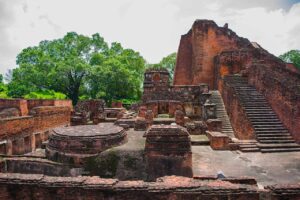
Nalanda is around 15 km from Rajgir and is usually part of the Buddhist tourism circuit. Nalanda was a Mahavihara, or a large Buddhist monastery situated in the ancient kingdom of Magadh. It was declared a UNESCO World Heritage site in 2016.

The Nalanda Mahavihara site is in the State of Bihar, in north-eastern India. It comprises the archaeological remains of a monastic and scholastic institution dating from the 3rd century BCE to the 13th century CE. It includes stupas, shrines, viharas (residential and educational buildings) and important art works in stucco, stone and metal. Nalanda stands out as the most ancient university of the Indian Subcontinent along with giants like Taxila (also called Takshashila), Pushpagiri, and Vikramshila. It engaged in the organized transmission of knowledge over an uninterrupted period of 800 years.

The historical development of the site testifies to the development of Buddhism into a religion and the flourishing of monastic and educational traditions. It is said that Mahavira spent fourteen monsoons in Nalanda. Gautam Buddha is said to have delivered sermons in a mango grove called Pavarika. One of Buddha’s disciples, Sariputra, was born in Nalanda and later attained nirvana here. The story goes that Emperor Ashoka had built a great temple at Nalanda at the site of Sariputra’s chaitya (shrine) in the 3rd century BCE. After being sacked by the Khiliji Turks it fell into disuse. Today, there are brick foundations and trees but 90% of the site remains unexcavated. The Ruins are spread over an area of 14 hectares with beautifully maintained gardens. A paved pathway runs across the entire complex connecting the Viharas (monasteries) and the Chaityas (temples).
Source:


